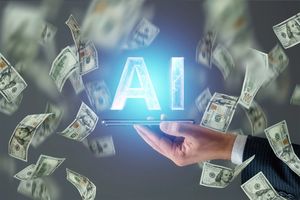
In an unprecedented surge of capital expenditure, technology titans Amazon (NASDAQ: AMZN), Microsoft (NASDAQ: MSFT), and Alphabet (NASDAQ: GOOGL), alongside Meta Platforms (NASDAQ: META), are collectively pouring hundreds of billions of dollars into AI infrastructure in 2025. This aggressive investment, projected to reach well over $300 billion this year alone and potentially near $500 billion by 2026 across these major players, signifies a fiercely competitive "AI arms race." The immediate implication is a rapid acceleration in AI development and adoption, creating an insatiable demand for specialized hardware, energy, and AI-driven services, while simultaneously widening the competitive chasm between these tech behemoths and smaller industry players. This monumental spending spree is not merely about technological advancement; it's a strategic imperative to secure a dominant position in the burgeoning AI-centric future.
The AI Gold Rush: Why Big Tech is Betting Billions
The current wave of massive AI infrastructure investment by Amazon, Microsoft, and Google, significantly surpassing an initial $100 billion collective figure, is a direct consequence of the "AI arms race" ignited by the public launch of OpenAI's ChatGPT in late 2022. This event served as a powerful catalyst, demonstrating the transformative potential of generative AI and compelling tech giants to invest heavily to maintain their competitive edge and avoid obsolescence.
Specifically, Amazon plans to spend over $100 billion in capital expenditures in 2025, with the vast majority directed towards AI for Amazon Web Services (AWS). This includes significant investments in data center capabilities, custom AI training chips like Amazon Trainium and Inferentia, and over $30 billion in new U.S. data center developments in states like Pennsylvania and North Carolina. Microsoft has earmarked approximately $80 billion globally for AI infrastructure in fiscal year 2025, with more than half bolstering U.S. capabilities within its Azure cloud platform. Notably, Microsoft is also investing $30 billion in the UK through 2028, half of which is dedicated to cloud and AI infrastructure, including building the UK's largest supercomputer with over 23,000 NVIDIA (NASDAQ: NVDA) GPUs. Google's parent company, Alphabet, initially projected $75 billion for 2025 but later increased its planned capital expenditure to a staggering $85 billion, primarily for AI-focused data centers and hardware, including its Tensor Processing Units (TPUs) and Gemini models. Google has also pledged nearly $7 billion in the UK for AI infrastructure and research over two years.
The timeline of this investment surge is remarkably swift. Following ChatGPT's debut, Microsoft announced a "unprecedented $10 billion" investment in OpenAI in January 2023. Google swiftly responded in February 2023 with a reported $300 million investment in Anthropic, followed by Amazon's $4 billion investment in Anthropic in September 2023, making AWS its primary cloud provider. These partnerships, combined with internal AI development, set the stage for the early 2025 announcements of multi-billion dollar individual investment plans, signaling an accelerated phase of the AI arms race.
Key players and stakeholders involved extend beyond these core three. Cloud hyperscalers like AWS, Microsoft Azure, and Google Cloud Platform are the foundational infrastructure providers. AI model developers such as OpenAI, Anthropic, and Google DeepMind are driving the demand for advanced infrastructure. Hardware manufacturers, particularly NVIDIA (NASDAQ: NVDA), dominate the market for AI GPUs, while Advanced Micro Devices (NASDAQ: AMD) and Taiwan Semiconductor Manufacturing Company (NYSE: TSM) are also crucial. Executives like Amazon CEO Andy Jassy, Microsoft President Brad Smith, and Google CFO Anat Ashkenazi are orchestrating these strategies. Governments, including those in the U.S. and UK, are actively seeking to attract AI investment, recognizing its strategic importance. Initial market reactions have been a mix of enthusiasm and caution, with investor scrutiny over the immense capital expenditures, leading to concerns about potential "AI bubbles" and the sustainability of returns, though many analysts see the underlying demand as fundamentally robust.
The AI Divide: Who Wins and Who Risks Falling Behind
Big Tech's monumental AI infrastructure investment is creating a clear bifurcation in the technological landscape, designating prominent winners and posing significant challenges for potential losers.
The most conspicuous winners are the hyperscale cloud providers themselves: Amazon (NASDAQ: AMZN) with AWS, Microsoft (NASDAQ: MSFT) with Azure, and Alphabet (NASDAQ: GOOGL) with Google Cloud. Their combined investment exceeding $300 billion in 2025, with Meta Platforms (NASDAQ: META) also contributing significantly, solidifies their dominance in cloud computing and AI services. By building proprietary AI-optimized data centers and developing custom chips (like Amazon's Trainium and Google's TPUs), they aim to embed AI across their core offerings, ensuring long-term revenue growth from AI models, tools, and services offered to enterprises. While heavy capital expenditures might temporarily pressure cloud gross margins, their strategic foresight positions them to capture the lion's share of the burgeoning AI market.
Semiconductor companies are perhaps the most immediate and significant beneficiaries. NVIDIA (NASDAQ: NVDA), with its near-monopoly in server GPUs and its CUDA software ecosystem, is the undisputed leader, experiencing massive revenue surges directly tied to Big Tech's insatiable demand for AI chips. Advanced Micro Devices (NASDAQ: AMD) is also a strong competitor, expanding its presence in high-performance computing and benefiting from the intensified demand for AI inference solutions. Taiwan Semiconductor Manufacturing Company (NYSE: TSM), as the world's largest semiconductor foundry, manufactures these advanced chips, enjoying strong revenue streams and pricing power regardless of which chip designer gains market share. Other beneficiaries include Broadcom (NASDAQ: AVGO) for custom AI chips and networking solutions, and Micron Technology (NASDAQ: MU) for high-speed memory crucial to AI workloads.
Beyond chips, data center infrastructure and equipment suppliers are thriving. This includes specialized GPU cloud providers like CoreWeave, traditional data center operators such as Digital Realty (NYSE: DLR) and Equinix (NASDAQ: EQIX), networking hardware companies like Arista Networks (NYSE: ANET) and Cisco Systems (NASDAQ: CSCO), and even suppliers of raw materials and heavy equipment like Caterpillar (NYSE: CAT) for data center construction. Server and storage providers such as Super Micro Computer (NASDAQ: SMCI) and Dell Technologies (NYSE: DELL) also see increased demand.
On the flip side, smaller AI and machine learning companies/startups face significant headwinds. The exorbitant infrastructure costs, coupled with Big Tech's bulk purchasing power, create severe bottlenecks in accessing crucial GPU resources. This leads to higher costs and longer lead times for smaller players, hindering their ability to innovate and compete, fostering a "winner-take-all" dynamic. Similarly, businesses struggling with cloud cost optimization will find the intensive computational demands of AI further exacerbate their struggles, as AI workloads drive up costs for VM instances, GPUs, and TPUs, potentially impacting profitability. Lastly, companies with primarily "asset-light" models that are unwilling or unable to make substantial capital expenditures in AI infrastructure risk being marginalized in an increasingly asset-heavy AI landscape. Even leading AI model developers like OpenAI face massive cash burn rates, putting pressure on their profitability and potentially leading to higher service prices for end-users.
A New Industrial Revolution: Broader Impacts and Regulatory Gaze
Big Tech's colossal multi-billion dollar investment in AI infrastructure is not merely a corporate spending spree; it's a fundamental restructuring of the global technological and economic landscape, ushering in what many consider a new industrial revolution. This massive capital injection is accelerating several profound industry trends. It is driving exponential demand for specialized hardware, particularly high-performance GPUs, cementing the dominance of companies like NVIDIA (NASDAQ: NVDA) and AMD (NASDAQ: AMD). Data centers are rapidly transforming into "AI fortresses," requiring unprecedented capital expenditure on construction, advanced chip procurement, and robust software development, with overall Big Tech capital expenditures projected to near $500 billion by 2026. The trend towards cloud-first AI deployment is intensifying, with approximately 65% of server spending now occurring in cloud environments, underscoring the scalability and flexibility required for AI workloads. Furthermore, tech giants are aggressively pursuing proprietary AI-optimized hardware and custom silicon, seeking to reduce dependency and optimize performance.
The ripple effects of these investments are far-reaching. While semiconductor manufacturers and cloud providers reap immense benefits, the high barriers to entry created by these massive costs raise concerns about an "AI monopoly, duopoly, or triopoly" emerging among the tech giants. Smaller AI startups face intense competition, exorbitant computational costs, and challenges in acquiring talent and quality data, potentially stifling innovation outside the established behemoths. However, a trend of "co-opetition" is also emerging, with Big Tech forming alliances and investing in AI startups like OpenAI and Anthropic. While these partnerships can accelerate product development, they also raise antitrust concerns regarding potential platform dependency and market concentration, prompting active investigations by bodies like the Federal Trade Commission (FTC).
From a regulatory and policy perspective, the scale and transformative potential of AI are drawing significant global attention. Antitrust bodies are scrutinizing these large investments and partnerships to prevent anti-competitive practices. The immense energy consumption of AI data centers is a growing concern, projected to consume a significant percentage of national electricity by 2030, raising issues of grid reliability, escalating energy prices, and sustainability. This has prompted companies like Microsoft (NASDAQ: MSFT) to explore novel energy solutions, including nuclear technology. Governments worldwide are also racing to introduce AI regulations, exemplified by the European Union's AI Act, to mitigate risks such as misinformation, biased algorithms, and privacy violations. The buildout of AI infrastructure is increasingly seen as a strategic tool in global politics, transforming AI capabilities into a matter of national competitiveness and security, spurring efforts in supply chain resilience and domestic chip development.
Historically, the current AI infrastructure boom draws comparisons to the Dot-Com Bubble of the late 1990s in its market exuberance, though many argue the underlying fundamentals are stronger today due to leading AI companies generating significant earnings. More profoundly, it's likened to the Industrial Revolution in its potential to fundamentally reorder industries and drive long-term economic growth. The rapid and massive scale of development also echoes the internet infrastructure buildout, a period that saw immense value creation but also significant market corrections for companies that couldn't sustain their growth. This investment signifies the "biggest tech infrastructure buildout in history," fundamentally restructuring how computational power will be distributed and leveraged in the AI age.
The Horizon: What Comes Next in the AI Era
Big Tech's unprecedented multi-billion-dollar AI infrastructure investment sets the stage for a dynamic period of transformation, both in the short and long term, demanding strategic pivots and opening new market opportunities and challenges.
In the short term, we can expect a continued surge in the capabilities and reach of cloud AI services. Companies like Microsoft are already seeing significant revenue boosts from AI-powered products like Copilot. Amazon's (NASDAQ: AMZN) $100 billion-plus investment in AWS infrastructure this year alone reflects its belief in AI as "the biggest opportunity since cloud." Hardware manufacturers, especially semiconductor giants like NVIDIA (NASDAQ: NVDA) and Advanced Micro Devices (NASDAQ: AMD), will continue to experience immense demand, further cementing their market positions. However, this aggressive spending also entails immediate challenges: temporary pressure on cloud gross margins due to high capital expenditures, increased investor scrutiny over return on investment, and significant strain on energy infrastructure as AI data centers require 2-3 times more electricity than traditional ones. Infrastructure bottlenecks, particularly in securing enough advanced chips and rapidly building out data centers, will persist.
Looking towards the long term, these investments are not expected to decelerate. Projections suggest capital expenditures could reach $500 billion annually by 2026 across major tech companies, with global AI data center spending potentially exceeding $1.4 trillion by 2027. This sustained growth is driven by the "AI scaling law"—larger datasets and more complex models necessitate greater infrastructure. Such scaling is expected to lead to transformative AI capabilities across scientific research, enabling AI to assist in complex scientific software development, mathematical proofs, and biological research by 2030. Economically, AI infrastructure is poised to become one of the most valuable global assets, potentially contributing over $15 trillion to the global economy by 2030, and increasingly treated as a strategic national asset.
Strategic pivots and adaptations are already underway. Companies are aggressively pursuing proprietary AI-optimized hardware and custom silicon to reduce reliance on single suppliers and optimize performance. For example, NVIDIA (NASDAQ: NVDA) is even collaborating with Intel (NASDAQ: INTC) on AI infrastructure. Addressing the immense energy demands is critical; tech giants are exploring new nuclear facilities, renewable off-grid sources, and hybrid partnerships with energy companies, with Microsoft (NASDAQ: MSFT) betting on nuclear power. Institutional investors are shifting from speculative software bets to long-term ownership of physical data centers, viewing them as essential "factories of the AI era." Supply chain resilience is also a key focus, driven by geopolitical risks and the desire to strengthen domestic tech leadership.
The market opportunities are vast. Beyond chipmakers and cloud providers, the energy sector will see a boom, as will data center construction, management, and associated services. The robust infrastructure will underpin the expansion of AI-driven applications across every industry imaginable. However, challenges are equally significant: existing power grids are already struggling to keep up, high capital costs raise questions about ROI amid rapid technological evolution, and supply chain vulnerabilities persist despite diversification efforts. Regulatory and ethical concerns around AI will continue to evolve, influencing investment trajectories. Talent shortages in AI development and infrastructure management could hinder progress, and the sheer scale of investment creates natural barriers to entry, potentially leading to market concentration among a few tech giants.
Potential scenarios include the entrenched dominance of Big Tech, establishing insurmountable competitive advantages for the next decade. Alternatively, AI infrastructure could increasingly be viewed as "AI Utilities," attracting more institutional capital for stable, long-term returns. A geopolitical race for AI supremacy is already unfolding, with control over semiconductor supply chains and AI infrastructure becoming a national security priority. The energy demands could also accelerate a transformation towards advanced, reliable, and carbon-free energy sources. Ultimately, if AI delivers on its promise of significantly increasing productivity, these investments could indeed spark a new economic paradigm, but the short term might see volatility due to high costs, rapid technological shifts, and the risk of technology obsolescence.
The AI Reckoning: A Concluding Assessment
Big Tech's collective investment of well over $300 billion in AI infrastructure for 2025, with projections soaring even higher in the coming years, marks a definitive pivot point in technological history. This unprecedented financial commitment, driven by a fierce "AI arms race," underscores an unwavering belief among industry leaders that compute capacity is the paramount battleground for future innovation and market dominance.
Key takeaways from this massive outlay are clear: it's not merely about software algorithms, but about building the foundational, physical backbone for an AI-centric world—hyper-scale data centers, custom AI chips (GPUs and non-GPU accelerators), and advanced network infrastructure. This spending is a strategic imperative for Big Tech to maintain a competitive edge, unlock efficiencies, and develop new products, creating a self-reinforcing growth cycle where more AI demands more compute, fueling continuous investment. Early signs indicate significant revenue generation for companies like Microsoft (NASDAQ: MSFT) and Amazon (NASDAQ: AMZN) (via AWS), suggesting a powerful monetization pathway.
Assessing the market moving forward, we anticipate continued aggressive expansion, with global AI spending potentially surpassing $2 trillion by 2026. This will inevitably lead to increased market concentration among the "Hyperscale 5" or "Magnificent 7" tech giants, whose performance in the AI race will disproportionately influence overall market dynamics. The entire AI supply chain, from chipmakers like NVIDIA (NASDAQ: NVDA) and Intel (NASDAQ: INTC) to power grid builders and cooling solution providers, is poised for significant gains. Economically, this investment could be a crucial counterforce to a decelerating economy, boosting GDP and creating numerous infrastructure jobs. High-margin returns, particularly from cloud services, are expected as AI model training becomes more compute-efficient.
The significance and lasting impact of this investment cannot be overstated. It will accelerate AI innovation, establishing new industry standards and platforms that will shape AI development for years. Geopolitical implications are profound, as the race for AI supremacy intensifies globally. Socially, AI is set to transform every sector, from automating tasks and optimizing supply chains to enabling entirely new services. However, critical concerns remain, including the enormous power and water demands of AI data centers, raising sustainability questions. There's also the "expensive AI risk" of escalating depreciation costs eating into profit margins if AI revenue doesn't keep pace, or if the rapid pace of innovation renders assets obsolete too quickly, leading some to draw cautious parallels to the dot-com era's overvaluation.
For investors, several key areas bear watching in the coming months:
- Monetization of AI Services: Closely monitor how quickly these massive capital expenditures translate into tangible revenue growth and improved profitability for Big Tech. Watch for signs of rising depreciation expenses impacting profit margins.
- Demand vs. Capacity: Assess whether the rapid infrastructure build-out aligns with actual demand for AI services to mitigate risks of overbuilding, which could lead to pricing wars.
- AI Supply Chain Performance: Keep a keen eye on the financial performance of companies across the AI supply chain, especially chipmakers and providers of power, cooling, and networking solutions, as their growth is directly tied to Big Tech's AI investments.
- Cloud Growth Rates: Observe the growth rates of cloud divisions (AWS, Azure, Google Cloud) as they are the primary vehicles for delivering AI services and monetizing these infrastructure investments.
- Regulatory Developments: Monitor evolving regulatory frameworks around AI governance, ethics, and antitrust, as these can significantly influence market dynamics and investment trajectories.
- Energy Solutions: Watch for advancements and investments in new, more efficient, and sustainable energy sources to power the ever-growing AI infrastructure.
Ultimately, Big Tech's $300 billion AI infrastructure gamble is a bold bet on the future. While the potential rewards are immense, the path forward will demand careful execution, continuous innovation, and astute navigation of both market dynamics and regulatory landscapes. The coming months will be crucial in demonstrating whether this unprecedented investment will truly usher in an AI-driven golden age or expose underlying fragilities in its foundation.


















